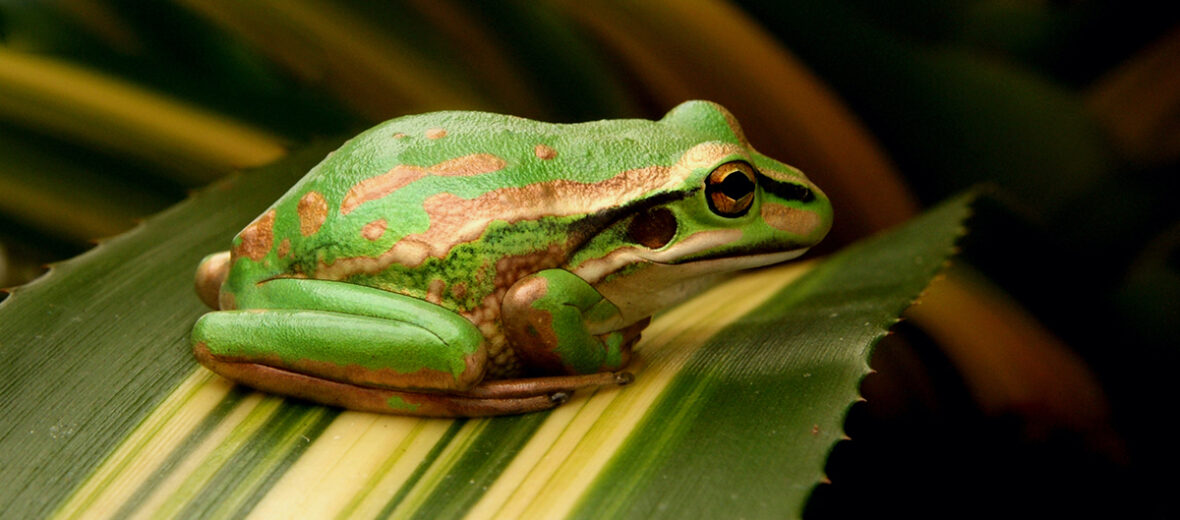
The bell frog, aka green bell frog, green & golden swamp frog, and green frog, hails from eastern Australia and northern New Zealand. With their populations decreasing more than 30% in the past 10 years, these frogs are listed globally as Vulnerable, Endangered under the New South Wales Threatened Species Conservation Act, 1995, and are considered an invasive and nuisance species in New Zealand.
First the Stats…
Scientific name: Ranoidea aurea
Weight: Up to 1.76 ounces
Length: Up to 4.5 inches
Lifespan: Up to 15 years
Now on to the Facts!
1.) Bell frogs are considered to be 1 of Australia’s largest frog species.
2.) While able to climb, these frogs spend most or all of their time on, or near, the ground.
3.) Crickets, mosquito wrigglers, larvae, dragonflies, cockroaches, flies, and grasshoppers are their main prey item, but they will also happily eat worms, crayfish, slugs, and even mice.
4.) These frogs are mostly diurnal (active during the day).
5.) Bell frogs are territorial and defensive towards each other. Fights often break out for territory and injuries & death occurs regularly; so does cannibalism.
But wait, there’s more on the bell frog!
6.) Like so many other frogs, bell frogs are also subject to Batrachochytrium dendrobatidis (Bd), or chytrid.
7.) The common name, “green and golden bell frog”, was first coined by Harold Cogger in his book Reptiles and Amphibians of Australia, in 1975.
Did you know…?
Because these critters are often found in water, their fingers lack webbing, while their toes are almost totally webbed.
8.) They were first described as Rana aurea by Lesson back in 1827, yet they have changed classifications multiple times.
9.) During the cooler winter months of May – August their colors darken significantly to allow for more sun to penetrate their bodies.
10.) In the breeding condition, males develop nuptial pads on their thumbs, that are used to grip females during mating (called amplexus). These are brown during the breeding season, but are less conspicuous and pale during the rest of the year.
But wait, there’s still more on the bell frog!
11.) Also during the breeding season, females take on a blueish hue on their feet, while the males’ legs turn a rusty orange.
12.) When they are handled, they secrete a slimy, acrid mucus, that consists of 17 aurein peptides. 13 of these present a broad-spectrum antibiotic and anticancer potential.
Did you know…?
Males produce a deep growl that has been described as a 4-part “walk-walk” sound that is reminiscent of a motorbike changing gears.
13.) The secretion not only makes the frog slippery and hard to hold onto but also is poisonous to other species of frogs.
14.) These critters have been documented traveling up to 1.86 miles in a single day!
15.) Their predators are many and include creatures like snakes, skinks, laughing kookaburras, kingfishers, red foxes, tortoises, eels, fish, and a range of invertebrate predators, like the large brown mantis. Australian Aborigines will also sometimes eat these frogs.
But wait, there’s still a little more on the bell frog!
16.) Females lay upwards of 11,682 eggs in a gelatinous mass placed on aquatic vegetation.
17.) Almost immediately after being deposited, the eggs expand to nearly 0.16 inch in diameter.
18.) Tadpoles hatch in up to 5 days. However, the hatching time can be as little as just a few hours!
19.) Tadpole survival rates are very low, due to multiple factors; primarily that of predation.
20.) The newly hatched tadpoles measure up to .24 inch long from end-to-end, and in just 6 months they can measure up to 2.36 inches in length.
Now a Short Bell Frog Video!
Be sure to share & comment below! Also, check out the Critter Science YouTube channel. Videos added regularly!
Want to suggest a critter for me to write about? Let me know here.
Some source material acquired from: Wikipedia
Photo credit: Bernard Spragg



